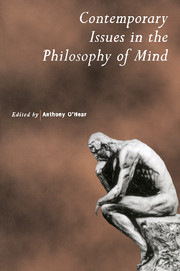Book contents
- Frontmatter
- Contents
- Notes on Contributors
- Introduction
- The Mind–Body Problem After Fifty Years
- How to Find the Neural Correlate of Consciousness
- Embodiment and the Philosophy of Mind
- Folk Psychology and Mental Simulation
- Understanding Other Minds from the Inside
- Self-knowledge: the Wittgensteinian Legacy
- Joint Attention and the First Person
- Consciousness as Existence
- Setting Things before the Mind
- Perceptual Intentionality. Attention and Consciousness
- Experience and Reason in Perception
- Intentionality as the Mark of the Mental
- Intentionality and Interpretation
- Externalism and Norms
- Mind, World and Value
- Mind, Knowledge and Reality: Themes from Kant
- The Modality of Freedom
- Dualism in Action
- Index
Perceptual Intentionality. Attention and Consciousness
Published online by Cambridge University Press: 12 May 2010
- Frontmatter
- Contents
- Notes on Contributors
- Introduction
- The Mind–Body Problem After Fifty Years
- How to Find the Neural Correlate of Consciousness
- Embodiment and the Philosophy of Mind
- Folk Psychology and Mental Simulation
- Understanding Other Minds from the Inside
- Self-knowledge: the Wittgensteinian Legacy
- Joint Attention and the First Person
- Consciousness as Existence
- Setting Things before the Mind
- Perceptual Intentionality. Attention and Consciousness
- Experience and Reason in Perception
- Intentionality as the Mark of the Mental
- Intentionality and Interpretation
- Externalism and Norms
- Mind, World and Value
- Mind, Knowledge and Reality: Themes from Kant
- The Modality of Freedom
- Dualism in Action
- Index
Summary
A representative expression of current thinking on the ‘problem of consciousness’ runs as follows. There is one, impenetrably hard problem; and a host of soluble, and in this sense easy problems. The hard problem is: how could a physical system yield subjective states? How could there be something it is like to be a physical system? This problem corresponds to a concept of consciousness invariably labelled ‘phenomenal consciousness’. It is here, with respect to phenomenal consciousness, that we encounter an ‘explanatory gap’, where it is this gap that makes the problem so hard. Nothing we can say about the workings of a physical system could begin to explain the existence and nature of subjective, phenomenal feel.
But, the story goes, we also have another cluster of concepts of consciousness, the explanation of which give rise to easy, that is, soluble problems. One such easily explicable concept is that of ‘consciousness of’, an account of which is exhausted by a theory of mental representation, or intentionality. The other easy concepts all bring in the idea that conscious states are accessible, in some sense, to the subject. Accounting for ‘access-consciousness’ is a matter of distinguishing in functionalist terms among different kinds of access-conferring relations among mental representations. These problems are all easy in the sense that we have a relatively clear picture of what it would be for a physical system to have states that represent the world and stand in such functional relations to each other.
- Type
- Chapter
- Information
- Contemporary Issues in the Philosophy of Mind , pp. 181 - 202Publisher: Cambridge University PressPrint publication year: 1998
- 7
- Cited by



